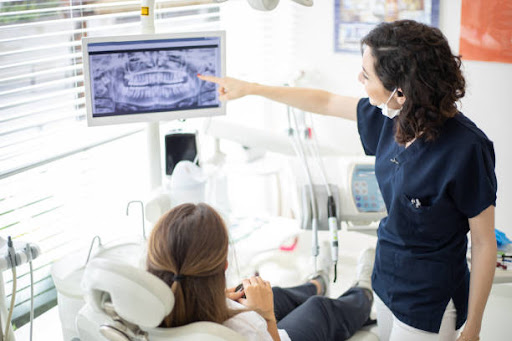
Gum disease is best prevented by practicing good oral hygiene at home and visiting your dentist regularly for checkups and cleanings.
When it comes to your dental routine, how do you know if it’s working? You may notice specific symptoms of gum disease when you brush and floss, and your dentist will observe less obvious signs during your dental examination.
Gingivitis is the early stage of gum disease. Generally, it is caused by poor dental hygiene, although certain diseases, aging, hormones, and other factors can also play a role. In the event that you notice any of the following symptoms, it may be time to consult your dentist regarding your gum health:
- Gums that are bright red or purple
- Swollen gums
- Tenderness or pain
- Whenever you brush or floss, you experience bleeding.
- Persistent bad breath
- Gum recession
Sometimes, there are no obvious symptoms at all. It’s for this reason that regular checkups are so important. You can reverse the effects of gingivitis by paying careful attention to your oral hygiene, receiving professional cleanings, using prescription mouthwashes, or undergoing other treatments as required.
Why should we be so proactive? When left untreated, gingivitis can develop into a more serious gum disease, called periodontitis.
Plaque and tartar contain bacteria that cause inflammation, which causes the gum tissue to pull away from the teeth, forming pockets that become deeper over time. Bacteria continue to multiply in those areas where brushing cannot reach, resulting in further inflammation, infection, and the eventual breakdown of gum and bone tissue.
Untreated periodontitis can lead to serious complications, including:
- Roots are more susceptible to decay due to significant gum recession.
- Periodontal abscesses
- Teeth that are loose or have shifted out of place
- loss of bone around the teeth
- Tooth loss
Your dentist may refer you to our periodontal office if you show signs of advanced gum disease.
A periodontist specializes in diagnosing, preventing, and treating gum disease. Upon completing dental school, a periodontist must complete an additional three years of advanced education. A periodontist is trained and skilled to treat gum disease surgically and nonsurgically, as well as to place dental implants and perform cosmetic procedures.
In addition to diagnosing and treating periodontitis, periodontists recommend a variety of procedures based on your specific needs. In order to restore your gum health, they offer the following treatments:
- Oral, topical, or time-release medications
- Scaling and root planing are non-surgical deep cleaning procedures that remove plaque and tartar from above and below the gum line and smooth tooth roots to remove bacteria and help the gums attach to the teeth again.
- Flap surgery can be used to treat persistent gum infection, reduce pocket depth, and re-secure the gums snugly around the teeth.
- Various regenerative procedures are available to help restore and repair tissue that has been damaged by gum disease, including bone grafts and gum grafts.
Be proactive if your dentist recommends a periodontal consultation. The best way to protect yourself from the serious consequences of untreated gum disease is to consult a specialist in this field. Periodontists have the knowledge and experience to treat gum disease, restore bone and gum tissue, and prevent it from progressing. Contact our periodontal office today to schedule an appointment.

















